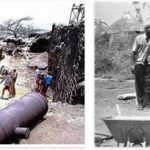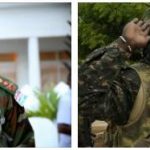Gambia is a West African country. Stretching along both banks of the Gambia River, it is surrounded by Senegal to the north, east and south, and is bathed by the Atlantic Ocean to the west. It is one of the smallest countries in Africa, with an area of 11 300 km2. In addition to the capital, Banjul, with a population of 36 100 residents (2004), other cities stand out, such as Serekunda (225 500 residents), Brikama (81 400 residents), Bakau (74 700 residents) And Farafenni (31,600 residents).
It is a flat country with a low coastline. The Gambia River allows rice farming to be one of the most important agricultural activities.
Climate
The climate is of the dry tropical type, that is, with a longer dry season than the rainy season.
Economy
Agriculture is the main sector of the economy, occupying 3/4 of the active population and contributing more than 1/4 to GDP. The peanut and cotton productions deserve to be highlighted. Fisheries have been developing rapidly, the same cannot be said for the industrial sector, which contributes less than 5% to GDP and employs an even smaller percentage. The Gambia’s main trading partners are Belgium, China, the United Kingdom and Japan.
Environmental indicator: the value of carbon dioxide emissions, per capita (metric tons, 1999), is 0.2.
Population
The population is 1,641,564 residents (2006), which corresponds to a population density of 141 residents/km2. The birth and death rates are respectively 39.37% and 12.25%. Average life expectancy is 54.14 years. The value of the Human Development Index (HDI) is 0.453 and the value of the Gender-adjusted Development Index (IDG) is 0.457 (2001). It is estimated that, in 2025, the population will be 2 654 000 residents.
Socially, the country is based on traditional structures, reflecting the presence of ethnic groups that form the following social framework: Africans [Mandingas (42%), Fulas (18%), Wolof (16%), Diolas (10%) and others ( 5%)] and non-Africans [1%]. The Muslim religion is followed by 95% of the population, while Christians represent 4%. The official language is English.
History
Originating in the Wolof, Madingas and Fulas tribes – which settled in the current territory of Gambia around the 13th century -, this former British colony had its first European contact with Portuguese navigators who, in 1455, reached the river Gambia. However, in 1588, Portugal sold the commercial rights to the river to England. The British then had to dispute it with the French, based in the enclave of Albreda, north of the Gambia River, until 1783, the date of the signing of the Treaty of Versailles. In this treaty the right was recognized, either by England on the river or by France on Albreda. Later, in 1857, France gave Albreda to the British and, in 1889, both countries defined the current borders. On January 18, 1965, The Gambia proclaims its independence. Becomes a member of the Commonwealth in 1970, withSir Dawda Kairaba Jawara as first president, re-elected to office in 1982 after a failed coup the previous year. At the same time, Gambia and Senegal created a confederation, called Senegambia, under which they sought to unite the military and security forces, coordinate foreign, economic and monetary policies and establish confederate institutions. However, this confederation would be dissolved in 1989, following the numerous political divergences observed between the two states. For Gambia democracy and rights, please check getzipcodes.
- Countryaah.com: Offers a full list of airports in the country of Gambia, sorted by city location and acronyms.
- Abbreviationfinder.org: Provides most commonly used abbreviations and initials containing the country name of Gambia. Listed by popularity.
Gambia – Government Map
Find a map of Gambia provided by the government. Also provides a comprehensive overview of the country’s history and geography.
Website: http://www.gambia.com/history/history.html
Gambia – Magellan Map
Features a close-up map of the region around Gambia, including a detailed view of Senegal.
Website: http://www.unctad.org/en/subsites/ldcs/country/maphtml/gambi
Gambia – WeatherHub Map
Features a close-view graphical map, indicating of the capital of Banjul and other key cities.
Website: http://www.weatherhub.com/global/ga_map.htm
National Geographic Map Machine – Gabon
Take a look at the topographical map of this African nation. Learn about the economy and population.
Website: http://plasma.nationalgeographic.com/mapmachine/index.html?i…


